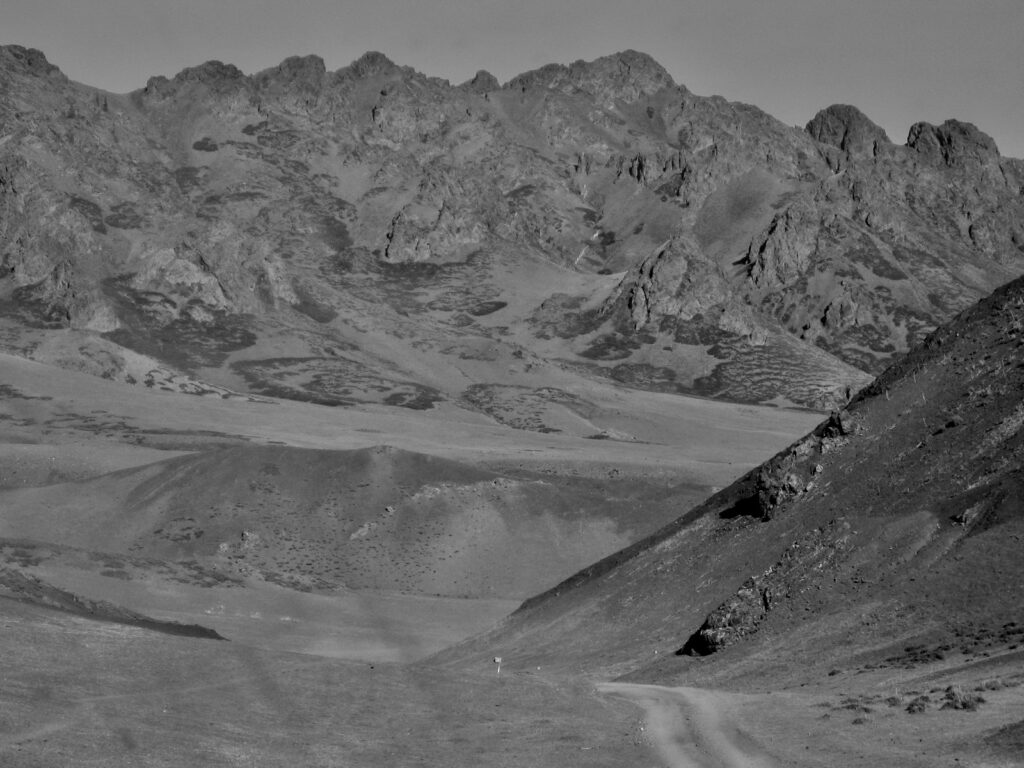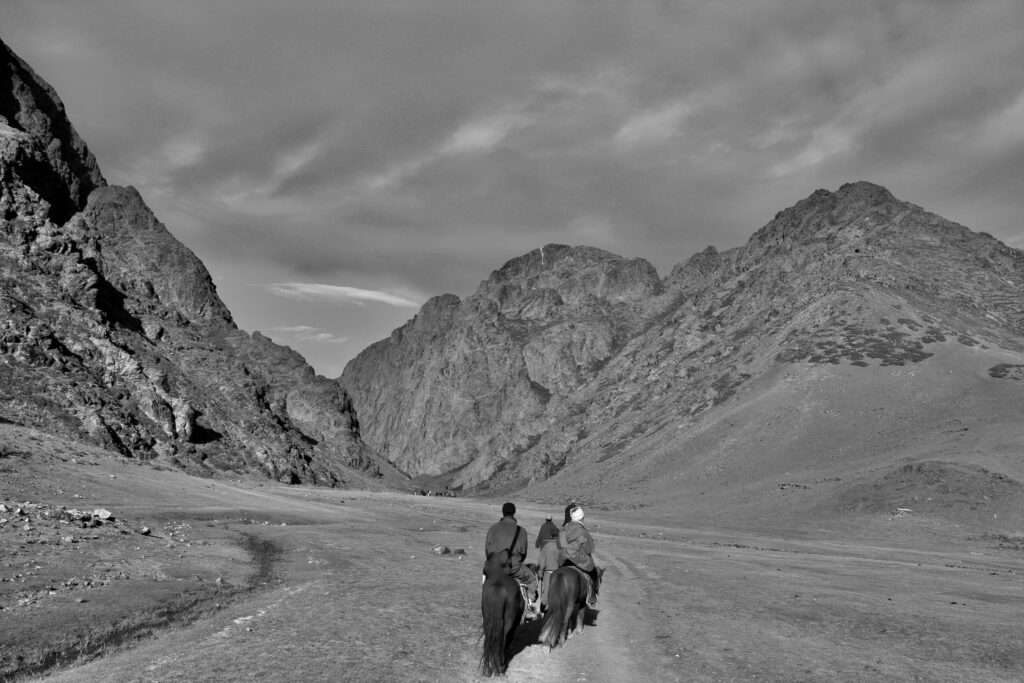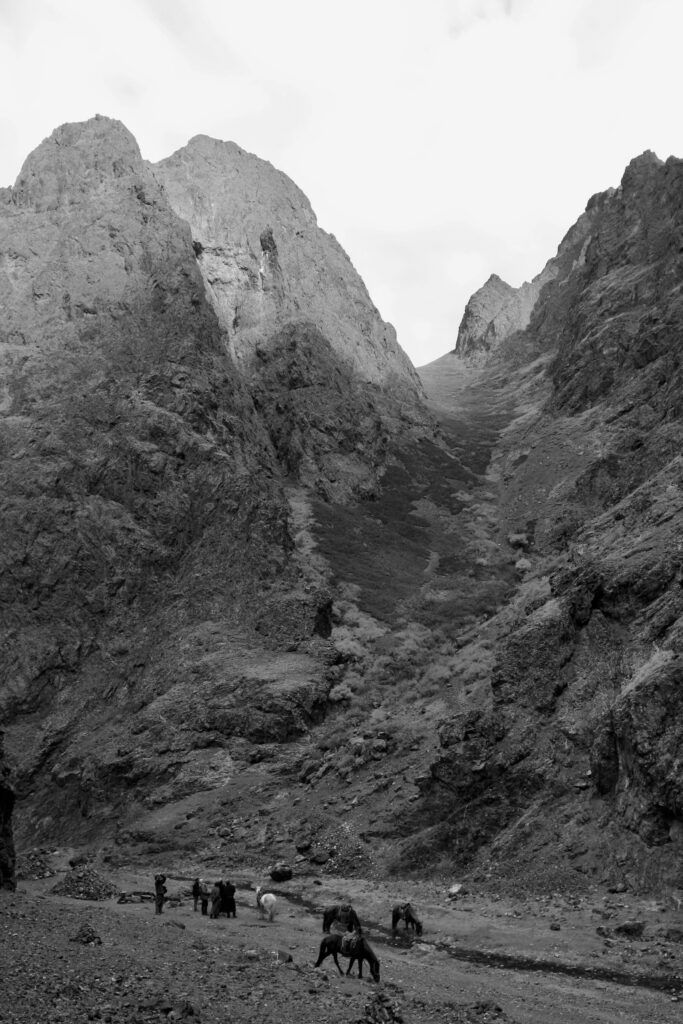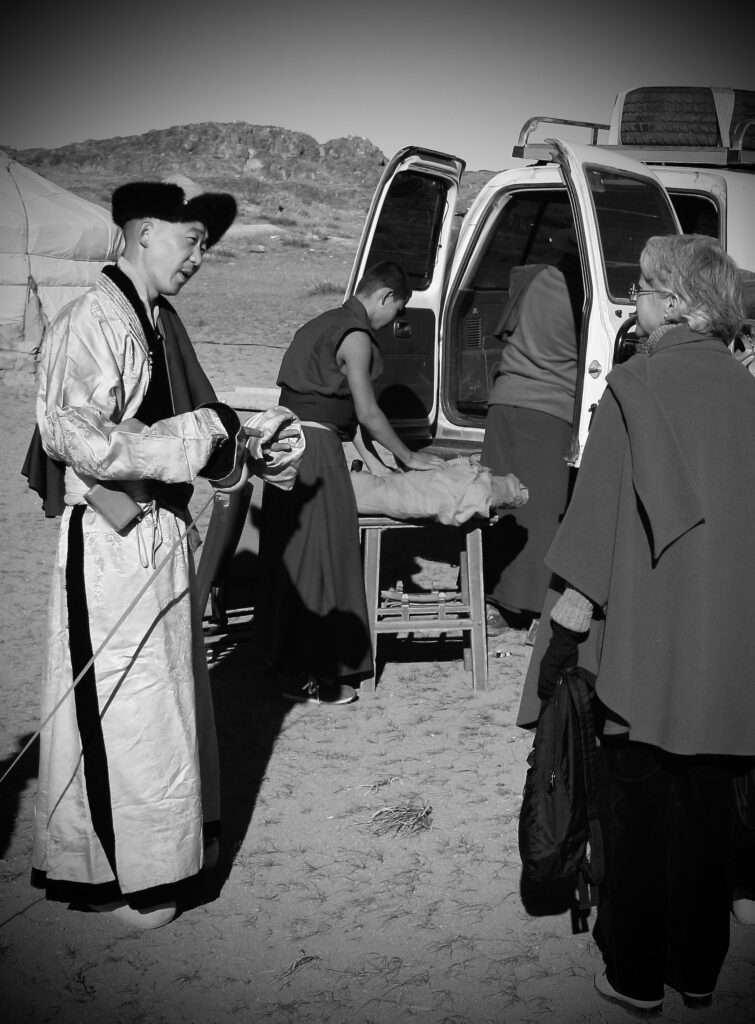This is the backstory to my music video on You Tube. It’s a long read. There are topic headings to help navigate your way. If you’re just interested in the music video, here it is.
Yolyn Am (Mong. Ёлын Ам)

On the long road to Yolyn Am (Mong. Ёлын Ам) in the Gobi is Gurvansaikhan National Park (Ömnögovi Aimag, Southern Mongolia). This particular valley is found in the Zuun Saikhanii Nuruu range of the Gurvan Saikhan Mountains. This area, as part of the Gobi Desert sees very little precipitation. However, Yolyn Am is notable for its deep ice field. Before the current impact of climate change, the ice field reached several meters thick by the end of winter, and was several kilometres long. 21 September 2005. Photo: C.Pleteshner

On horseback (CP in ear-warming bandana) at the entrance to Yolyn Am (Mong. Ёлын Ам) in the Gobi Gurvansaikhan National Park (protected as a national reserve in 1965 and becoming part of the national park in 1993). Yolyn Am goes through between high rocky mountain massifs, a formation of Paleozoic gabbros. It was originally established to conserve the region’s bird life but it’s now more famous for its dramatic rocky cliffs and narrow, heavily shaded canyons that allow sheets of blue-veined ice to survive well into the summer. A narrow stream flows through the valley. Yolyn Am is 46km west of Dalanzadgad, the capital of Ömnögovi Aimag and 540kms south of the nation’s capital Ulan Bator. 21 September 2005. Photo: L.Rigdol

As you go deeper into the valley, it gets cold! When we visited in 2005, Yolyn Am was still inhabited by mammals and birds: Yol vultures (gypaetus barbarous) with white feathers around their neck, the tiny and cautious Altai snow cock, ibex and wild sheep (both cliff climbers and difficult to see because of how their colour blends in so seamlessly with the natural environment.) Ibex are wild goats, the species in Asia’s mountains called the Siberian Ibex. They typically live above the tree line. A male Ibex’s most distinctive feature is undoubtedly his long, scimitar-shaped horns which can sometimes grow to nearly five feet long, and it is the largest species of wild goats in the world. On this particular day, a splendid male Ibex and his small entourage chose to reveal themselves to us. That is what we are all staring at! 21 September 2005. Photo: L.Rigdol.
______________________________
About the Photographs
I was first introduced to Mongolia’s scholar-poet Zava Damdin rinpoche (1976- )* in 2004 when visiting Amarbayasgalant near the Siberian border in northern Mongolia. There for many years since childhood, he had first been a young monk (taken there by his father around the time of the collapse of the Soviet Union) to eventually, after years of study, emerge as their Teacher-in-residence.
Whereas in 2004 I had first travelled to Mongolia with a group, at Zava rinpoche and his mother Jantsan Gundegmaa’s invitation, the following year I returned for a longer stay, this time travelling alone. By that time, Zava rinpoche, members of his extended family and students had relocated to the Gobi and had begun building Delgeruun Choira near Delgertsoght. I would spend the northern summer of 2005 there, living in a monastic community with Rinpoche’s extraordinary tutelage and care. So what’s this got to do with the photographs? Well …
That summer, I remained within the grounds of the monastery’s precinct the entire time. There are no freeloaders in the desert. There is always work to do, the chop wood/carry water aspect of day-to-day life. There are also texts to study and translate, ceremonies and teachings to attend, the needs of many fly-in fly-out foreign visitors to accomodate, and of course the daily meditation practices to also somehow squeeze in. To be clear, it was not just sitting on a comfy cushion somewhere in a bourgeois setting listening to a discourse on ‘mindfulness’. As a resident, mindfulness is assumed. Everything flows from there.
“Care is like the soft soil of our earth.”
(ZDR 7 Dec 2023)
This more traditional form of training, which I affectionately refer to as gelug-pa bootcamp or a kind of spiritual athleticism, is not for everybody, to be sure. In such a remote location, over the summer, all manner of personal skills were to be honed: the more efficient management of one’s own precious time, and in relation to that of others; the ability to think on one’s feet and communicate with others in more than one language, often at the same time; and of course, the inner and expressed qualities of patience and endurance, just to name a few of the challenges on the spiritual athlete’s “to do” list. In my own small life’s journey, preparing for, and actually completing this particular retreat has been one of the best things I’ve ever done!
In the culturally and locally-embedded Khalkha Mongol lineage of Gelugpa Buddhist training, restricting one’s travel is just one of the mandatory requirements of completing this kind of scholarly meditation retreat. However, doing this sort of thing back in 2005 was for sure! not a common practice for a (western) woman in Mongolia, if at all. I can best describe this first summer in the Gobi as being an inter-cultural borderland adventure for everyone involved. So complex, so busy, so multi-cultural, so challenging, so joyful and so much fun! … As to the flow on effects of this in-total experience? Well …
Through the self-discipline of remaining within the grounds of the monastery, on a number of occasions certainly not so easy to do given the entertaining distractions and invitations to go elsewhere also on offer, I met many wonderful Mongolian people (of all ages) who came to contribute and be involved in a myriad of ways. Now nearly two decades on, some of these initial encounters have deepened, maturing into honourable and reciprocal friendships. Others have simply drifted away, like specks of dust on the move towards their own yet-to-be chartered horizons.
In due course, I did manage to complete the designated and inter-related tasks required of me for “the retreat” on time. I feel this a remarkable accomplishment, given the intense flurries of activity and all the other goings on. Any of you who have also attempted to do this sort of thing will know what I mean right? … and then … the totally unexpected reward ….

Mongolia’s scholar-poet Zava Damdin rinpoche (1976- ) and CP in conversation (Delgeruun Choira in the Gobi). 19 September 2005. Photograph courtesy of L.Pagchog.
By now, the Sun’s warmth was becoming weaker. Autumn had arrived. Both day and night temperatures were beginning to steadily drop. Here in the Gobi, the relationship between people living in nomadic gers (Mong. for yurts) which we were doing at the time, and the weather is very close.
One day, we just packed up what we needed, loaded the monastery’s vehicles and set off on a roaring road trip across the Ömnögovi with Zava Damdin rinpoche as our leading tour guide. This included a mid-morning horse ride into Yolyn Am. It would have been early morning but the mandatory national park guides turned up late … not so unusual, heh?
The Ömnögovi (Mong. Өмнөговь) is an aimag (Mong. for province) sometimes also referred to as the South Gobi. It is Mongolia’s largest aimag. Here in this part of our world, the distances between the few and small urban settlements are considerable. This particular road trip, through the rich and varied experiences choreographed on our behalf, opened my eyes to so many aspects of Mongolian history, cultural and nomadic life. How am I ever to repay such generosity and kindness …
* NOTE: For readers with interests in Tibetan gelug buddhism, it is important to point out that the scholar-poet Zava Damdin rinpoche (1976- ) is not ethnic Tibetan. Rather, he was born and lives in Mongolia, is of Khalkha Mongol ethnicity and is the holder-custodian of an important Mongolian gelug tutelary lineage. In terms of the Mongol-Tibetan cultural interface in Mongolia, a topic a number of other articles have already explored in some depth, I consider it important to occasionally remind those of you who enjoy reading my blog, to make a mental note to remember to differentiate between the two cohorts and their respective tutelary lineages. Whilst on the surface they may appear similar, below the waterline they are not.
__________________________________
Autumn in the Gobi
Mongolia has four distinct seasons: Winter (November to February), Spring (March to mid May), Summer (mid-May to late August) and Autumn (September to October). Here, the climatic transition from Summer to Winter (Autumn) is very brief.
In the Gobi, the weather in September is characterised by generally pleasant temperatures (around 20°C ) and also low rainfall. At this time of year, the Gobi’s strong winds are also less restless. In the absence of the noise of vehicular traffic, a kind of pristine stillness has arrived to imbue the air … Whilst overnight temperatures can drop to 6°C, by early October daily temperatures begin their steep descent towards those of Mongolia’s deep winter. However, in October, its still an average of -4°C to +12°C during the daytime and between -8°C to +5°C at night.
These photographs were taken in the Autumn of 2005. Readers, I offer you these real-world images for consideration, and pose the question: Could these particular images be a worthy alternative visual representation for a musical composition’s Autumnal mood?
__________________________________
Music’s Visual Representation
Here, there are no maroon and yellow maple leaves, or long avenues of deciduous trees planted in honour of those now long passed, to illustrate Autumn. By the time we rode into the gorge, the early morning fog too had dispersed, with the rising of the Sun. So how does one go about, in a more interesting way, representing an association between music’s Autumnal mood, as both the title of the music and this intermedia post to my blog suggest?
In search of my own answer to this question, I came across D.C. Hernández’s PhD thesis (2014), Brahms the Autumnal and the Romantic Aesthetic of Dissolution. This very interesting study explores the notion that Brahms’s music evokes the autumnal by examining its expressive quality with the hypothesis that his works embody the Romantic ideal of dissolution through a number of specific compositional techniques.
In one of the chapters, Hernández argues that dissolution (the process of dissolving) was for the Romantics a means of intuiting the spiritual in the physical. Here, notions of decay (such as those we generally associate with Autumn after Summer’s flush) underpin an interest in the in-between; such as twilight and in the distance, thereby providing a basis for the Romantic conceptions of inward-ness and resignation to its varying degrees.
Similarly, I think it fair to say that the visual representation of music is intimately connected to our inner life and its personal associations. Not only what the season of ‘Autumn’ may mean to you (this can and does change), but also in relation to the musical sounds that you’ve grown accustomed to, or now choose to link to those meanings: the instrumentation, their tempo, their timbre and so forth.
In reference to the European-Romantic ideal of dissolution? I too ‘see’ beauty in decay. As for Autumn? I ‘see’ a kind of cool and pensive atmosphere that offers a distinct emotional shift away from summer’s busy-ness to that of a more mellow and reflective time. In this online inter-media proposition, what I cannot help readers ‘see’ are the many different scents that also imbue the Gobi’s Autumnal atmosphere.
For the “Cool Autumn” music video on You Tube’s visual element in this intermedia composition, I’ve used the veins of leaves. Why? Because from certain perspectives, such a visual image can represent how we are all connected, each to the other, in one way or another.
______________________________
About the Original Music
Adagio “Cool Autumn” is an abbreviation of “Adagio Cool Autumn rock ballad (fog)” from the printed original Mongolian title, Adagio “Сэрүүн намар” рок балетын хөгжим (манан), another beautiful etude in Works for Piano (Vol. 2, 2013, pp36-39) by Mongolian composer and pianist Byambasuren Sharav (1952-2019). The original is arranged to be performed as a duet on 2 pianos. Because of the overlap in notation, for a live performance 2 pianos are required.
______________________________
About the Cover Version
After some experimentation, I settled on inter-weaving one part from the original piano duet with the sounds of other musical instruments using VSTs (Virtual Studio Technologies) that feature real-time MIDI-control of digital physically modelled pianos and related instruments. Multi-track recording seemed like a basic way to produce music, but it turned out to be a very different and enjoyable way of approaching how to make music.
Musical improvisation, also known as extemporisation, is the creative activity of in the moment musical composition, which combines performance with communication of emotions and instrumental technique, as well as a spontaneous response to other musicians, or in this case, the emerging synthesis of a number of different instrumental sounds.
__________________________
My interpretation of the music’s ‘Autumnal mood’
To establish an Autumnal mood, the original piece is set in a minor key, with resolutions to major keys for balance and to add a little drama. The main tempo throughout is slow and steady, like the horse trek into Yolyn Am. I ‘hear’ the suspended, 7th and diminished chords as reflections of an ‘in-between-ness’. Musical figures that have downward contours further support the mood, settling. And there’s a touch of dissonance, a lack of final resolution given the final delayed, suspended and broken chord.
__________________________
Multi-Track Recording and Arranging
For the cover version, in addition to Piano 1 (NY Steinway D Studio) and Piano 2 (NY Steinway grand) from the original duet:
- The sound of the solo clarinet has been added for moodiness.
- Tone colour is the general term we use when describing the distinctive sound of an instrument. The huuchir (Mong. for erhu) adds varying amounts of vibrato and raspiness (in contrast to the silky smoothness of the clarinet). It also generates a pulsating effect. Auditory roughness and dissonance from timbres produced by instruments such as the huuchir can affect emotion recognition and perception in listeners. A listener’s ethnicity [‘westerner’ or ‘asian’] is considered one of the variables. See K.M. Lim (2018) Meaningful noise : auditory roughness and dissonance predict emotion recognition and cross‐modal perception.
- And the dry and woody sound of an acoustic bass goes very well with the sound of the piano don’t you think?
- And finally, sounds from the distant memories synth pad have also been used as a reference to a sense of russification in Mongolia, one of a number of cultural overlays at play in contemporary Mongolian society in Mongolia today. In anthropology, we refer to this as lamination.
- The sound of the morin khuur is not included in this mix. I consider this best left to musicians from Mongolian lineages of musical training.
Piano 2 and melodic improvisation binds this cover version together, seven tracks in all. As my music tutor in New York jazz pianist Ron Drotos would say, ‘Remember to personalise the music to which you are drawn.’ This is my latest attempt to do so here …
Please refer to the INDEX for other articles and music that may be of interest.
© 2013-2024. CP in Mongolia. This post is licensed under the Creative Commons Attribution 4.0 International License. Documents linked from this page may be subject to other restrictions. Posted: 5 December 2023. Last updated: 14 October 2024.
